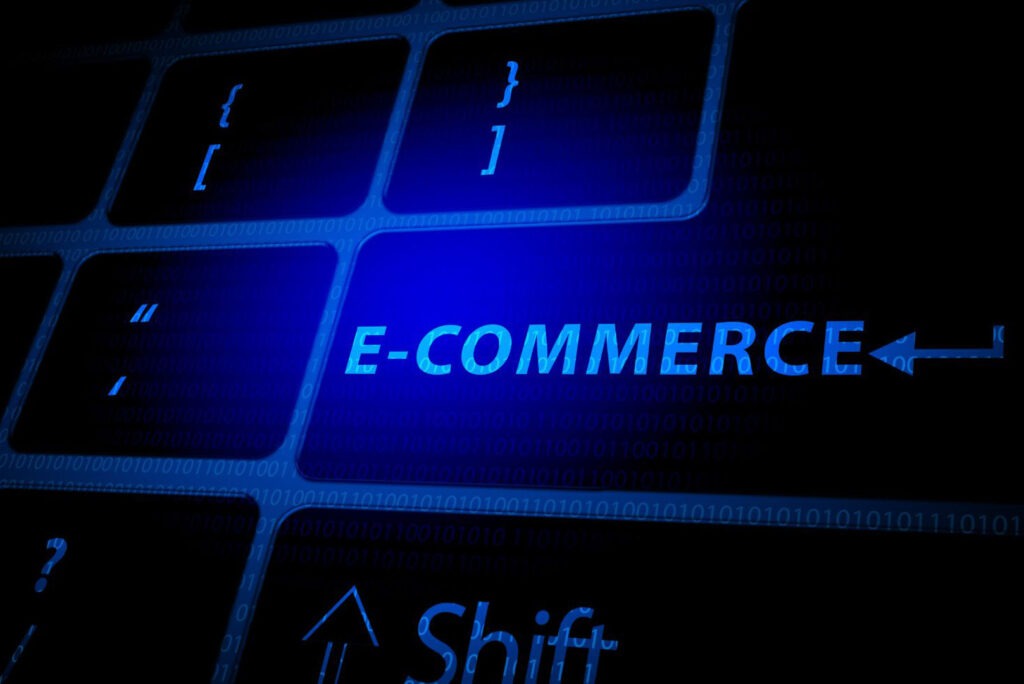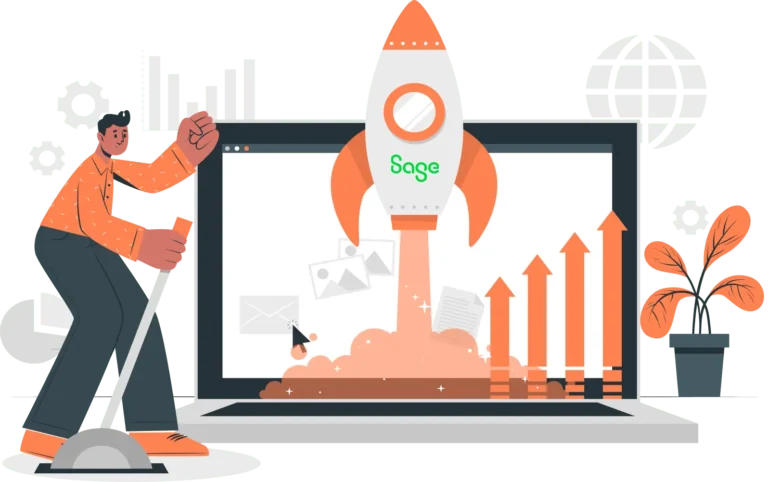
Blog / How to Set Up a Sage 100 Shopify Sync (Step-by-Step Guide)
How to Set Up a Sage 100 Shopify Sync (Step-by-Step Guide)
November 5, 2025
Transform your Shopify store with CertiPro’s E-Link, the ultimate solution for seamless Sage 100 Shopify sync. Many businesses struggle to manage orders and inventory as they grow. While manual processes work up to a certain point, they often break down and become a barrier to continued growth.
Boosting automation and streamlining your business processes via a Sage 100 and Shopify sync resolves bottlenecks and improves scalability.
In this step-by-step Sage 100 Shopify integration guide, we’ll cover how real-time data synchronization works and the benefits it can provide for your business.
Need help setting up a Sage 100 Shopify sync? Contact us today to see what we can do for your business.
Key Takeaways
- Automate Your Workflow: Syncing Sage 100 with Shopify transfers orders, inventory, and customer data automatically, reducing manual entry and errors.
- Step-by-Step Implementation: A clear setup process makes even complex integrations manageable, from connecting accounts to configuring real-time sync rules.
- Maintain Real-Time Accuracy: Ensure stock levels, pricing, and order status are always up to date, preventing overselling and fulfillment delays.
- Support All Sales Channels: Works seamlessly for B2B, B2C, and hybrid operations, keeping pricing, inventory, and customer info consistent.
- Increase Efficiency and Growth: Automation frees your team to focus on strategic tasks, helping your business scale faster.
- Avoid Common Errors: Proper configuration prevents duplicate orders, mismatched SKUs, and incomplete customer data.
- Maximize ERP ROI: A Sage 100 Shopify connector ensures your technology investment delivers measurable operational and financial benefits.
Table of Contents
- Introduction to Sage 100 Shopify Sync
- Why Sync Sage 100 with Shopify? Key Benefits
- Pre-Sync Checklist: What You Need Before You Start
- Step 1: Connect Sage 100 to Your Shopify Store
- Step 2: Configure Data Mapping and Sync Settings
- Step 3: Training and Ongoing Support
- Common Issues with Sage 100 Shopify Sync and How to Fix Them
- Best Practices for Maintaining a Smooth Sync
- Conclusion: Streamline Your Operations
- Contact Us
- Sage 100 Shopify Sync FAQs

Introduction to Sage 100 Shopify Sync
Streamline your business processes, eliminate manual data entry, and achieve real-time synchronization between your online storefront and Sage 100 ERP system. Designed for businesses of all sizes, E-Link ensures better efficiency, accuracy, and scalability by automating critical workflows like order processing, inventory updates, and accounting.
Without an integration between them, your Sage 100 application and Shopify webstore exist as separate, siloed systems, which can lead to problems, including oversells, delays, and poor customer service. An integration marries your front-office Shopify store with Sage 100’s robust back-office capabilities. It creates a real-time bidirectional sync, keeping data consistent and accurate between your core business platforms.
Unlike generic middleware, CertiPro’s E-Link is tailored to meet diverse integration needs. Whether you’re passing orders automatically when placed online or syncing product data, E-Link handles it with precision. Every business is unique, and E-Link adapts to your specific requirements, whether you’re running a SaaS-based Shopify platform or an on-premises Sage 100 setup.
E-Link addresses key integration considerations, including security, performance, and accessibility. It supports both SaaS and on-premises environments, ensuring secure data sharing and optimal performance regardless of your setup. CertiPro’s E-Link empowers your business to grow by connecting your eCommerce and ERP seamlessly.
Why Sync Sage 100 with Shopify? Key Benefits
Syncing Sage 100 with Shopify provides multiple benefits to businesses. While the specific advantages may vary based on customization and use, in general, these are the Sage 100 ERP Shopify sync top benefits:
- Real-Time Data Visibility – A Sage 100 Shopify sync provides visibility into real-time sales data, allowing your business to adapt quickly to changing market conditions. You’ll be able to make better decisions armed with real-time data.
- Automated Data Sync – Data flows automatically between your core business platforms without the need for manual intervention, reducing manual tasks and ensuring consistency across your core business platforms.
- Better Order Management – Orders placed online will automatically flow into your Sage 100 application for immediate processing. This reduces delays and improves order processing times, ensuring that you get products out the door faster.
- Better Inventory Management – Inventory will remain consistent between your webstore and ERP, including real-time updates. This prevents oversells and allows you to make better decisions about procurement and inventory management.
- Streamlined Workflows – Shopify ERP integrations automate manual processes and streamline workflows, which boosts efficiency and lowers operational costs.
- Better Data Accuracy – Automatic updates and real-time syncing eliminate manual data entry and re-keying, which improves data accuracy.
- Better Customer Service – Streamlined workflows, better data accuracy, and faster order processing results in better customer service. Customers can also see shipping and tracking updates on your website without the need for customer service emails or phone calls.
With Sage 100 Shopify automation, you can streamline order processing, inventory updates, and customer data management between your ERP and online store in real time.

Pre-Sync Checklist: What You Need Before You Start
Before you integrate Sage 100 and Shopify, it’s important to ensure compatibility and do some additional legwork to prepare your systems for the switch.
These are the steps we recommend our clients take before we begin our E-Link Sage 100 Shopify integration implementation.
- Active Sage 100 Account – First, verify that you have an active, updated Sage 100 account, as well as all the necessary permissions.
- Check Your Shopify Store – Next, check your Shopify store setup and hosting provider. It’s important to have your Shopify login with admin privileges ready. (It’s no problem if you don’t have a Shopify store and are looking to set up your Shopify store at the same time as your Sage 100 integration).
- Choose an Integration Product and Provider – Now it’s time to choose your integration product and provider. There are several Sage 100 Shopify syncs on the market, and it’s important to choose one that fits the needs of your business. We recommend prioritizing middleware solutions that are flexible so they can grow with your business. You should also look at the provider’s support options and determine the types of ongoing fees involved. Some solutions may have transaction or volume fees, which we usually recommend that our customers avoid if possible.
- Backup Your Data – Before making a major change to either your ERP or Shopify store, it’s always a good idea to backup your data to prevent the loss of critical information.
Step 1: Connect Sage 100 to Your Shopify Store
After choosing an integration provider, we move on to the implementation process. For our E-Link product, a typical implementation takes 12-16 weeks, although the full timeline depends on the customers’ needs and customizations.
- Data Accuracy in Sage 100 – Confirm the accuracy of data in your Sage 100 application, including product SKUs, pricing, inventory levels, and customer information. This will prevent syncing errors. You might work with your integration provider to delete or archive incorrect or unnecessary data.
Step 2: Configure Data Mapping and Sync Settings
- Map Data Connection Points – Determine what types of data need to be synced between platforms, and map data connection points to match your workflow.
- Implement the Sage 100 Shopify Sync – Your implementation provider should handle the bulk of the implementation process with assistance from your IT department.
- Testing – Test the integration, including seeing how it handles test orders, inventory changes, and more. It’s important to verify the sync before going live on your production accounts.
- Go Live – Once everything is verified and the integration is ready, it’s time to go live. We recommend doing this at off-peak hours to minimize the impact on your customers.
Step 3: Training and Ongoing Support
- Training – Train employees on your new Sage ERP integration and how it will change your existing workflows.
- Ongoing Monitoring and Support – Once the integration goes live, it’s important to perform ongoing monitoring to ensure that the integration continues working correctly. Shopify or Sage updates may break your integration, or you may need to change your data connection points. We recommend that our customers go with integration providers who provide ongoing support, including making additional customizations if necessary.

Common Issues with Sage 100 Shopify Sync and How to Fix Them
As we’ve previously covered, Sage 100 Shopify syncs can break or may require additional updates. These are some of the top problems with a Sage 100 integration and how to fix them.
- Duplicate Orders – A single eCommerce order may sync into Sage multiple times, creating false duplicates.
- Inventory Mismatches – If stock levels aren’t updated correctly or there’s a syncing delay, inventory may be inaccurate or become inconsistent between your core business platforms.
- Customer Data Errors – Incomplete or inaccurate customer records may not correctly sync between Shopify and Sage 100 ERP.
- Failed Payment or Order Status Updates – Connection errors or mismatched settings may result in failed payments or incorrectly updated payments and orders.
- Delayed Syncs – Delayed syncs can lead to inaccuracies or inconsistencies between your core business platforms.
- Integration Crashes or Middleware Errors – Your Sage 100 Shopify sync may fail due to outdated software versions, software updates, server issues, or corrupted configuration files.
Some of these issues can be solved by ensuring that your integration is configured correctly from the beginning. Ideally, your Sage 100 ERP Shopify integration partner should handle them, including updating the middleware to ensure it remains compatible with new versions of Sage 100 and Shopify.
Effective troubleshooting Sage 100 Shopify sync issues helps quickly resolve data mismatches, inventory errors, and order processing delays to keep your eCommerce operations running smoothly.
Best Practices for Maintaining a Smooth Sync
These are the best practices for maintaining a smooth Sage 100 Shopify sync.
- Schedule Regular Data Audits – Periodically review synced data between Sage 100 and Shopify to catch any discrepancies.
- Keep Your Integration Software Updates – Make sure to keep your Sage 100 application, Shopify webstore, and integration up to date. This improves performance and security.
- Monitor Sync Logs and Alerts – We typically recommend that clients review sync logs to spot any failed transactions or skipped records. Set automated alerts if possible.
- Test Changes Before Going Live – As always, test any changes or updates before going live. Ideally, any major changes should be done in coordination with your Sage ERP integration partner.
- Coordinate with Your ERP Partner – Stay in regular contact with your integration provider. Your provider should help you monitor system health and provide updates or other support as needed.

Conclusion: Streamline Your Operations
A Sage 100 Shopify integration streamlines operations and lowers operating costs while providing a better customer experience. It’s one of the best ways to set your company up for future growth. In today’s fast-moving competitive landscape, increasing efficiency and adopting the latest business technology is crucial for retaining an edge over your competition and growing your market share.
What We Can Do for You
Our E-Link Sage 100 Shopify sync stands out for its versatility and flexibility. We can build whatever functionality you need. When you go with us, you’ll never face transaction or volume fees.
Our E-Link Shopify integration can even handle customer-specific pricing and inventory for B2B sales.
Ready to Streamline Your Sage 100 and Shopify Integration?
Don’t let manual data entry and sync errors slow your business down. Get started with a real-time Sage 100 Shopify sync today and unlock seamless order, inventory, and customer management.
Contact Us
Sage 100 Shopify Sync FAQs
What is Sage 100 Shopify sync?
A Sage 100 Shopify Sync is an automated integration that connects your Sage 100 ERP system with your Shopify store. It enables real-time data exchange for orders, inventory, customers, and products, which eliminates manual entry and ensures that both platforms stay perfectly aligned.
A Shopify Sage 100 product sync keeps your product listings, pricing, and inventory levels consistent across both platforms for a seamless eCommerce experience.
Why should I integrate Sage 100 with Shopify?
Integrating Sage 100 with Shopify helps businesses streamline eCommerce operations, boost efficiency, and increase scalability. A Sage 100 Shopify connector improves accuracy in order processing, automates inventory updates, reduces shipping errors, and provides customers with real-time product availability.
Optimizing your Sage 100 Shopify workflow allows your team to manage orders, inventory, and customer data efficiently without switching between systems.
What data can be synced between Sage 100 and Shopify?
A Sage 100 ERP Shopify sync provides an automated bi-directional data exchange between your Sage 100 and Shopify platforms.
It syncs data including:
- Orders and invoices
- Customer records and addresses
- Product catalogs and pricing
- Inventory levels and stock updates
- Shipping and tracking details
How do I set up a Sage 100 Shopify sync?
We recommend that our customers following these steps to set up a Sage 100 ERP Shopify sync:
- Verify your Sage 100 and Shopify accounts are properly configured.
- Choose a reliable Sage 100–Shopify integration tool and Sage integration provider, like CertiPro’s E-Link.
- Map your data fields between Sage 100 and Shopify.
- Implement the integration.
- Test order imports and exports.
- Enable automatic syncing for live data exchange.
- Train employees.
- Implement ongoing monitoring and support.
Following a step-by-step guide ensures a smooth and error-free setup.
What are the benefits of a real-time Sage 100 Shopify sync?
A real-time Sage 100 eCommerce integration provides numerous benefits to businesses. It streamlines processes, increases automation, and improves the customer experience. It keeps your data continuously updated and consistent between your core business platforms. That means your Shopify customers always see correct inventory counts and pricing, while your Sage 100 system automatically receives order details and payments. This reduces backorders, boosts customer satisfaction, and accelerates fulfillment.
Do I need a developer to connect Sage 100 and Shopify?
It depends on the type of middleware or integration used. Some Sage 100 eCommerce integrations are designed for quick setup with minimal coding, while others are more complex and require custom development.
In our experience, while no-code Sage 100 Shopify connections may work for companies with simpler workflows, they’re often not a fit lor larger customers with higher transaction volumes, complex customer workflows, or pricing logic. Implementing a more flexible or customizable sync requires a developer or certified Sage partner who can help with advanced configuration and data mapping.
Can I sync multiple Shopify stores with Sage 100?
Yes, a robust Sage 100 Shopify sync supports multiple Shopify stores under one Sage 100 instance. This is ideal for brands managing multiple storefronts or sales channels, allowing centralized control of orders, inventory, and fulfillment.
How often does data sync between Sage 100 and Shopify?
Most Sage 100 Shopify integrations offer either real-time or scheduled syncing. CertiPro’s E-Link product creates a real-time automated data sync between platforms, meaning it updates data instantly as changes occur. Scheduled syncing can be set at intervals, depending on business needs and server capacity.
What issues can occur during a Sage 100 Shopify sync?
The most common problems with a Sage 100 Shopify sync are either that it stops working and no longer provides an automated data exchange, or syncs data incorrectly, leading to errors. Common sync issues include mismatched SKU codes, missing product mappings, or incorrect tax settings. These can be avoided by carefully reviewing your data fields and testing your Sage 100 Shopify sync setup before going live.
Integrating your Sage 100 accounting and Shopify store ensures that all sales, invoices, and payments are automatically recorded, giving you accurate financial insights in real time.
How do I choose the best Sage 100 Shopify sync solution?
When our clients evaluate different Sage 100 Shopify sync tools, we recommend that they consider the following attributes:
- Does the tool provide real-time, bidirectional syncing?
- Does it support custom fields and pricing logic?
- Is it compatible with your Sage 100 version?
- Does the integration provider offer expert support and easy implementation?
Solutions like CertiPro’s E-Link are built specifically for Sage 100 and Shopify integration, offering enterprise-grade reliability.
Will a Sage 100 Shopify Sync affect my current workflows?
A properly configured Sage 100 Shopify sync streamlines and enhances workflows. It automates repetitive data entry while preserving your current Sage order processing, accounting, and reporting structure.
A Sage 100 order integration ensures that every Shopify sale is automatically captured in your ERP system, eliminating manual data entry and reducing fulfillment errors.
How much does a Sage 100 Shopify sync cost?
The cost of a Sage 100 Shopify sync varies based on your integration provider, number of stores, and customization needs. Pricing can range from a few hundred to several thousand dollars annually, depending on feature depth and support levels.
How do I integrate Sage 100 with Shopify?
The best way to integrate Sage 100 with Shopify involves using middleware to create a real-time, automated data exchange between your core business platforms. Typically, this involves finding a third-party integration provider and working with them to implement the data sync.
The Sage 100 Shopify connector for real-time updates ensures that inventory, orders, and customer information are instantly synchronized between your ERP and Shopify store.
How to automate Shopify orders in Sage 100?
Use a Sage 100 Shopify integration to automatically sync orders, inventory, and customer data. Once connected, Shopify orders flow directly into Sage 100 without manual entry, keeping your systems up to date in real time.
Seamless ERP and eCommerce integration allows businesses to unify backend operations with online sales channels, improving efficiency, accuracy, and customer satisfaction.
What’s the best way to sync Sage 100 inventory with Shopify?
The best way is to use a Sage 100 Shopify integration that automatically updates inventory levels in real time, ensuring both platforms stay accurate and in sync.
How to connect Shopify to Sage 100 ERP?
Connect Shopify to Sage 100 ERP using a dedicated integration or connector that syncs orders, inventory, and customer data automatically between the two systems.
How to set up Sage 100 Shopify sync?
Set up a Sage 100 Shopify sync by installing a dedicated integration, connecting your Sage 100 ERP and Shopify store, mapping your data fields, and configuring real-time or scheduled syncing.
Accurate data mapping between ERP and eCommerce ensures that products, customers, and orders are correctly synchronized, preventing errors and maintaining consistent information across systems.
What is a Sage 100 Shopify sync setup checklist?
A Sage 100 Shopify sync setup checklist outlines the steps and requirements to connect your systems, including verifying data accuracy, mapping products and customers, configuring sync settings, and testing before going live.
Can I connect multiple Shopify stores to Sage 100?
Yes. A robust Sage 100 Shopify integration can connect multiple Shopify stores to a single Sage 100 instance, allowing centralized management of orders, inventory, and customer data.
How to sync orders from Shopify to Sage 100?
Use a Sage 100 Shopify integration to automatically import Shopify orders into Sage 100, updating inventory, customer data, and sales records in real time.
Implementing order and inventory automation ensures that stock levels and sales orders are updated in real time, reducing errors and streamlining fulfillment processes.
Does Sage 100 integrate with Shopify?
Yes. Sage 100 can integrate with Shopify using a dedicated connector or middleware to sync orders, inventory, and customer data automatically between the two platforms.
Implementing order and inventory automation ensures that stock levels and sales orders are updated in real time, reducing errors and streamlining fulfillment processes.
What data syncs between Sage 100 and Shopify?
Orders, inventory levels, product information, customer data, and pricing can all be synced automatically between Sage 100 and Shopify.
Supporting both B2B and B2C online stores with a unified platform enables businesses to manage wholesale and retail operations efficiently while providing a consistent shopping experience.
Do I need a plugin to connect Sage 100 and Shopify?
Yes. Connecting Sage 100 and Shopify typically requires a dedicated integration or connector to automate data syncing between the two platforms.
A Sage 100 API integration enables seamless communication between your ERP and external platforms, allowing for automated data exchange and real-time updates. It improves Shopify order management and provides business process automation.
How much does a Sage 100 Shopify integration cost?
The cost of Sage 100 Shopify integration varies based on multiple factors, including the product chosen, the customizations needed, and the number of stores you connect to Sage 100.
An eCommerce ERP connector links your online store with your ERP system, automating order processing, inventory updates, and customer data management for a seamless workflow.

